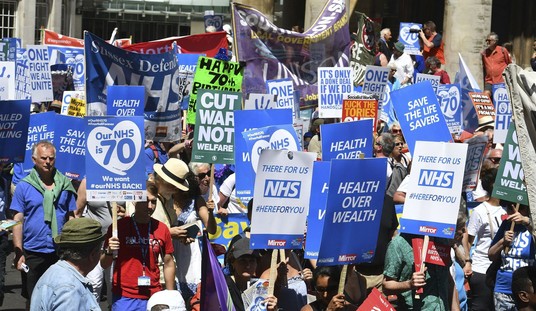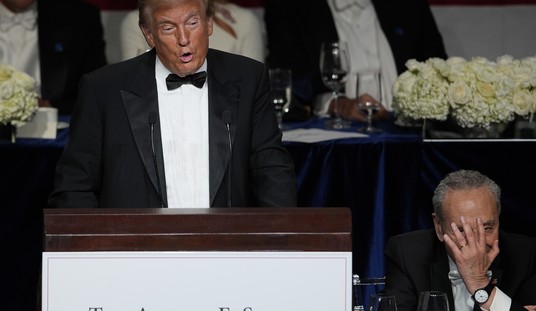And almost a third of respondents still say they’re unfamiliar with ObamaCare, even as we approach T-minus one month for the individual exchanges. Among those familiar with the Affordable Care Act, though, a majority disapproves, according to Gallup’s latest poll:
Less than two months before the health insurance exchanges open nationwide, more Americans disapprove (49%) than approve (41%) of the Affordable Care Act. An additional 11% have no opinion. As this landmark legislation enters the next phase in its implementation process, it remains divisive. With the exception of a bounce likely caused by President Barack Obama’s re-election in November 2012, Americans have been more disapproving than approving of the healthcare law.
Additionally, more Americans are pessimistic than optimistic about the future impact of the law. Less than a quarter believe it will make their family’s healthcare situation better, while 38% say it will make it worse. When asked about the law’s impact on the healthcare situation in the U.S., 35% say it will make the situation better, while 44% say it will make it worse. Americans’ views are essentially the same as they were in June.
Familiarity in this case breeds contempt. For those mostly or fully unfamiliar with the bill, it has a 36/39 approval rating — statistically an even split, but a poor result nonetheless for the administration’s signature legislation three years after its passage. Among those who have been following ObamaCare, though, the approval rating slumps to 42/55, with only 2% undecided. It’s a flop, in other words.
ObamaCare gets the highest approval in the age demo with the least familiarity, 18-34YOs, where only 10% are “very familiar” and 36% are mostly or fully unfamiliar with the law. (That may be because a good portion of that age bracket will stay on their parents’ insurance now, and don’t have to acquire insurance for themselves, too.) Still, it’s almost an even split on approval/disapproval of the ACA in this age demo, 44/40, hardly a big boost to the bill’s standing.
Thanks to a series of high-profile setbacks this week — announcements of employers dumping spousal coverage and limiting hours — the likelihood of a big run on subsidies next year will start ObamaCare early on its unsustainable path. What will be the endgame? In my column for The Fiscal Times, I suggest that it might not be the endgame that Harry Reid and other Democrats think:
If this collapses, what’s the endgame for Obamacare? Senator Harry Reid told a Nevada PBS panel that the ACA was only the first step. “What we’ve done with Obamacare is a step in the right direction,” Reid said, “but we’re far from having something that’s going to work forever.”
The ultimate goal of Obamacare was to “work our way past” health insurers altogether, Reid explained, and when asked whether that meant a national health program, Reid replied, “Yes, yes, absolutely, yes.” Senator Tom Coburn warned last year that Democrats designed the ACA to be a gateway to single-payer, government-run health care, and Reid apparently agrees.
However, Reid and his fellow Democrats may end up with a much different outcome than they desire. The primary problem with health-care costs is the third-party-payer system, especially for routine care. That system has been resistant to change because of the employer-subsidy model that arose during World War II as a way to get around wage freezes. …
The ACA will break the employer-subsidized payer model, but not in a way that makes the government-subsidy payer model work any better. The issue won’t be insurers in the exchanges, but the subsidies themselves. The subsidies are the unsustainable element in a rush away from the employer model. The only rational method to deal with the avalanche of subsidy demands is to allow for less-comprehensive insurance plans that charge lower premium rates or to tax Americans into poverty to fund them.
The most rational choice for coverage, especially for younger Americans, is a policy that covers hospitalizations only, with routine care funded through health-savings accounts. Providers are already moving to retail models, rejecting insurance affiliations (especially Medicare) and the red tape that accompanies that kind of business. That model provides pricing signals directly to the consumer, which will stabilize health-care costs much faster and more successfully than government intervention has.
Jeffrey Singer explains the benefits of market forces for true reform, in the Wall Street Journal:
Hospitals and other providers make their “list” prices as high as possible when negotiating contracts with health plans and Medicare regulators. No one is ever expected to pay the list price. Anybody who has seen an “Explanation of Benefits” statement from a health plan will note a very high charge from the provider, and an “adjusted charge” based upon the contracted fee schedule, which usually leaves the patient with little or nothing in out-of-pocket expenses. The only people routinely faced with list prices are those few people who have insurance like my patient’s—that doesn’t include a pre-negotiated fee schedule with contracted providers—or those who have no insurance.
Most people are unaware that if they don’t use insurance, they can negotiate upfront cash prices with hospitals and providers substantially below the “list” price. Doctors are happy to do this. We get paid promptly, without paying office staff to wade through the insurance-payment morass.
So we canceled the surgery and started the scheduling process all over again, this time classifying my patient as a “self-pay” (or uninsured) patient. I quoted him a reasonable upfront cash price, as did the anesthesiologist. We contacted a different hospital and they quoted him a reasonable upfront cash price for the outpatient surgical/nursing services. He underwent his operation the very next day, with a total bill of just a little over $3,000, including doctor and hospital fees. He ended up saving $17,000 by not using insurance.
This process taught us a few things. First, most people these days don’t have health “insurance.” They have prepaid health plans. They pay premiums to take advantage of a pre-negotiated fee schedule arranged for and administered by a third party. My patient, on the other hand, had insurance.
Second, even with the markdown for upfront “cash-pay” patients, none of the providers was losing money on my patient. Otherwise they wouldn’t have agreed to the prices. With the third-party payer taken out of the picture, we got a better idea of the market prices for the services. It is the third-party payment system that interferes with true price competition, so “market clearing prices” can’t develop.
Dr. Singer also uses the same examples of true market-run health care, Lasik and cosmetic surgery, to show how a proper market not only controls costs and prices, but also encourages new providers to enter those markets. Quality and innovation continually improve in those markets, thanks to price transparency and open competition for customers, and providers don’t have to spend a significant amount of their time dealing with insurers or the government instead of their patients.
At some point, we will get to truly rational health-care reform, even if we have to get there by default.








Join the conversation as a VIP Member